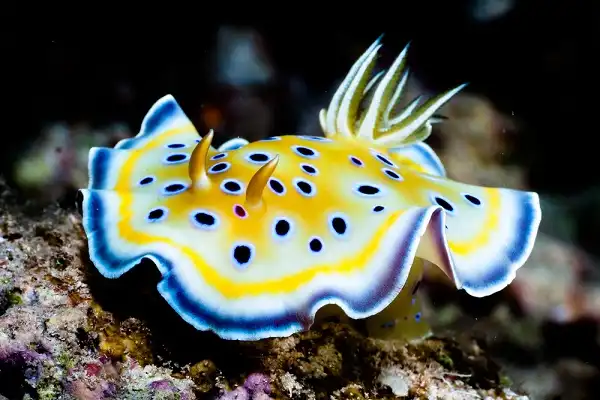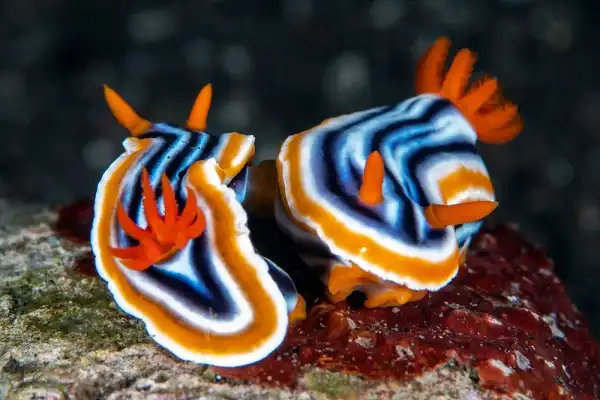Nudibranchs are some of the most diverse and captivating creatures found in our oceans. From their unique shapes and vibrant colors to the range of behavior they exhibit, these small sea slugs are sure to awe any ocean lover. Of all the fascinating facts about Nudibranchs, perhaps one of the most interesting is their adaptability; they inhabit a wide variety of climates from cold waters near Alaska to warm tropical shallow coral reefs around Australia’s Great Barrier Reef. In this blog post, we’ll explore different species of Nudibranches, how they survive in harsh marine environments, and what we can learn from them.

Nudibranch Description
Nudibranchs are small, soft-bodied sea slugs that come in an incredibly wide range of shapes and sizes. Most Nudibranches have two antennae that protrude from the head and they may also have two pairs of appendages known as rhinophores extending from their back. These rhinophores act like a sixth sense, helping them detect smells and tastes in the water. The appearance of Nudibranches can vary greatly depending on their species, some have vibrant colors while others are more muted and plain looking. Common colorings include yellow, red, purple, blue, green, black, or white. Many species also display intricate designs such as stripes or spots which can be used to identify them in the wild. Some Nudibranches even have bright fluorescent colors under certain light conditions! Nudibranchs have no shell or external skeleton, but instead, they maintain a tough skin for protection against predators. This skin usually has ridges and bumps which are often reflective or luminescent. The vibrant colors of nudibranchs often serve as camouflage, both when they are at rest on the sea floor and when they move swiftly through the water column.
Nudibranch Habitat
Nudibranchs are found in a variety of marine habitats across the world, from shallow coral reefs to deep-sea beds. They are most often seen on coral reefs or rocky shorelines in warm, tropical areas like the Great Barrier Reef in Australia. However, some species can also be found in cold waters near Alaska or along the coasts of Europe and North America. Nudibranches thrive in a variety of places, including mud flats and estuaries, wrecks and manmade structures, kelp beds, and rocky shores, as well as open ocean areas with little vegetation. Nudibranchs feed mainly on sponges and other small organisms like worms and mollusks living on coral reefs. This diet provides them with additional protection through chemicals stored in their bodies, such as toxins from sponges which can be used to deter predators from eating them. In order to find food sources or potential predators, they rely heavily on their antennae-like projections known as rhinophores. Nudibranchs have adapted to survive in harsh marine environments due to their hardy skin which is usually ridged and bumps that can be reflective or luminescent. To further protect themselves against predation, many species have evolved intricate patterns and designs that serve as camouflage or warnings to would-be predators.
Nudibranch Diet
Nudibranchs feed mainly on sponges and other small organisms like worms and mollusks living on coral reefs. Their diet is also supplemented with some algae, bacteria, detritus, and occasionally hydroids or other invertebrates. Nudibranchs typically use their antenna-like rhinophores to smell food sources or potential predators. In some instances, they may even actively hunt for small organisms on the seafloor. Overall, nudibranchs are fascinating creatures with a diverse diet that ranges from small invertebrates to bacteria and other organic matter found on the sea floor. They have evolved intricate defense mechanisms such as chemical defenses and camouflage patterns that allow them to survive in harsh marine environments and deter potential predators from targeting them as prey.

Nudibranch Size
Nudibranchs come in a variety of sizes, ranging from one millimeter to over 30 centimeters in length. The smallest species are the size of a grain of rice while larger species can measure up to 10 cm long. Other species may reach 20-30 cm in length and can weigh up to 45 grams. The size of the nudibranch also depends on its particular habitat and diet. In general, those living in shallower waters tend to be smaller than those living in deeper waters due to the availability of food sources. In addition, certain diet choices may also affect their growth rate and overall size. For example, nudibranchs that feed on sponges tend to be larger than those that feed on hydroids or other organisms.
Nudibranch Lifespan
Nudibranchs have a relatively short lifespan, typically ranging from 2 weeks to 4 months depending on the species. The larger species are known to live longer than the smaller ones, but even they typically fall within this range. The maximum lifespan for most nudibranchs is 1 year, which is quite short compared to other marine animals such as sharks and turtles. Nudibranchs typically reach their adult size within 2 weeks of hatching from eggs and begin mating soon thereafter. Mating can occur several times during their lifetime due to their ability to store sperm for later use when conditions are favorable. After mating, females lay clusters of eggs in sheltered areas which quickly hatch and the cycle begins again.
Nudibranch Behavior
Nudibranchs are primarily active during the night, as they search for food sources in the dark. During the day, they rest on the sea floor or in sheltered areas of reefs where they can remain hidden from predators. At night, they become more active hunters, actively seeking out prey items. While hunting, some species produce luminescent organs which help them blend into their surroundings and deter potential predators. In addition to being predatory animals, nudibranchs also possess a variety of defense mechanisms to protect themselves from predation. These include bright colors that act as camouflage during both rest and movement through the water column. Some species also exude toxins from glands located at the edge of their mantle in order to deter potential predators that might try to eat them.

Nudibranch Speed
Nudibranchs are not known for their speed and agility; they typically move around slowly and methodically in search of food. Their movement is largely determined by environmental conditions, including currents and water temperature, which can cause them to drift from one region to another. They mainly use their rhinophores (sensory organs) to detect minute changes in the water pressure or temperature that could indicate a potential food source nearby. In addition to drifting with ocean currents, some species may have specialized swimming abilities that allow them to move quickly when needed.
These specialized movements include the jet propulsion technique which involves forcefully expelling water out of the back end of the nudibranch in order to propel itself forward with greater speed and efficiency. The larger species such as Flabellina affinis and Tritonia plebeia are also able to swim with a flapping motion similar to rays and sharks. On average, most nudibranchs move at a rate of about 2cm/min, but this can vary greatly depending on environmental conditions such as current strength. Some species have been recorded moving up to 10cm/min while others may hardly move at all due to strong currents or lack of food sources nearby. In general, these creatures rely more heavily on drifting than fast bursts of speed in order to get around their environment efficiently.
Nudibranch Hunting
Nudibranchs are expert hunters, relying on a combination of their senses and bodily reactions to locate prey items in their environment. Using their long, sensory rhinophores (which can detect minute changes in the water pressure or temperature) nudibranchs can quickly and accurately detect potential food sources nearby. They also have specialized organs with luminescent pigments that allow them to blend into their surroundings and provide camouflage while hunting at night. When they come across a potential food source, nudibranchs will assess the item visually before using their radula (toothed tongue) to tear it apart.
Their radula is sharp enough to pierce through the thick shells of mollusks and other small invertebrates like hydroids, sponges, and polychaetes. After dismantling the prey item, nudibranchs secrete enzymes from special glands located at the tips of their body which help break down the food before consumption. In addition to feeding on small invertebrates, some species may also scavenge for dead or decaying organic matter or hunt for larger animals such as jellyfish and sea cucumbers with relative success. To ensure successful hunting trips during times of low food availability, some species even engage in aggressive mimicry – taking on the form and coloration of another animal in order to fool its prey into thinking it’s something else entirely!
Nudibranch Reproduction
Nudibranchs reproduce in a variety of ways, with the most common being spawning and external fertilization. In most cases, females will release eggs into the water which are then fertilized by males using their spermatophores (packages of sperm). The eggs typically have a sticky texture which helps them attach to various surfaces such as rocks or seaweed. After hatching, the larvae will go through several developmental stages before reaching adulthood.

Conclusion
Nudibranchs are true marvels of the marine world, having evolved a wide range of behaviors and adaptations that have enabled them to colonize many different habitats all across the globe. From their remarkable luminescent organs used for camouflage while hunting, to their ability to drift along ocean currents in search of food – these small yet mighty sea slugs are truly fascinating creatures worthy of admiration! The combination of these special abilities coupled with their incredible speed and agility has allowed nudibranchs to thrive despite their short lifespans. Truly, it is no wonder why they remain one of the most beloved species among marine biologists today!
Frequently Asked Question

